by Lorrie Kazan
Remote Viewing is the ability to transcend time and space and see into the future, target an event and literally project one’s mind there. From the early 1970s to the 1990s, Remote Viewing was used by our government Special Forces, including the C.I.A. and D.I.A., in order to psychically monitor world issues and find hidden targets. For example, remote viewer Joe McMoneagle accurately described the Soviets building a larger submarine than anyone had believed possible. McMoneagle’s vision was considered folly until the Soviets proudly revealed the largest submarine ever conceived.

Dr. Alexis Champion (attending from France), Jim Channon, Pam Coronado, Dr. Melvin Morse, Glenn Wheaton
Dr. Alexis Champion (attending from France), Jim Channon,
Pam Coronado, Dr. Melvin Morse, Glenn Wheaton
The Conference featured many of RV’s heavy hitters, such as Lyn Buchanan, Stephan Schwartz and Glenn Wheaten. Physicist Russell Targ was in the front row, and chiming in appropriately as needed.
How does RV differ from clairvoyance? It’s given precise protocols, utilized by military recruits uncomfortable with the word “psychic,” and generally involves a team of 5-25 participants. It’s labor intensive, and must produce solid and measurable results.
Teams are comprised of top level scientists and physicists, whose work has been documented and accepted by the most prestigious journals and organizations. While it’s considered that anyone can be trained to produce results, those with more psychic inclination tend to exhibit higher level of ability. (See www.lorriekazan.com/books_01.html)
The work of artist, initiator and original viewer, Ingo Swann, was featured in presenter Stephan Schwartz’s film. In the film, we witness Swann, and an equally powerful female remote viewer, precisely locate lost ships sunken beneath the ocean’s floor. Even the most sophisticated sonar equipment failed to track these vessels until directed by the RV team.
Description of one craft’s contents included tiny bottles, which when found turned out to be medical bottles. Could the viewers have read about the ship beforehand? Until it was found, no record existed of this particular lost ship.
Remote Viewers intentionally describe in adjectives and adverbs, rendering line drawings of the shapes they see; they avoid nouns. Nouns indicate analytical overlay, which is where one’s mind takes the lines and shapes and decides what it is and/or what it means.
“A noun is a box you hide things in,” stated Lyn Buchanan. It’s the monitor’s job to lead the viewer back to visual descriptions and away from concrete assumptions.
The audience participated in two experiments during the conference. First, presenter Marty Rosenblatt divided the room in half so he could lead us in 1ARV. 1ARV is a protocol that evolved from the work of the 10-member Aurora RV Group and was further refined during a 3-day workshop that involved Russell Targ, Marty Rosenblatt, and Jon Knowles.
While a bit confusing to follow and a little too complex to detail, I’ll give a quick sense of it here. Briefly, each side of the room had a separate blind target to describe. Blind means that the picture was sealed within an envelope and it was our job to describe was we psychically saw.
Our ultimate task was to determine the over/under for a Yankees game to be played in a few hours. To achieve this, one side of the room was assigned to represent the over, and the other side, where I was sitting, represented the under. Each side had a concealed target, i.e., a picture hidden in an envelope.
We used remote viewing to sketch the designs we perceived were hidden. Afterward, each side of the auditorium scored the other sides’ accuracy by rating hits and misses.
It was clear that the “under” side had the highest hits on the unseen target. The “over” side had lower scores than expected, which only bolstered the idea that betting on the under was the way to go. (This was about an hour and a half before the game even started.)
Later, after those who bet were joyously counting their money, Russell Targ shared that he’d tallied the statistics, and when he realized that our group had predicted an 85% probability for the under, he wagered another $200.
Many years before, Targ’s own team at Stanford had predicted the daily activities of the silver market. I believe they stopped at $100,000 profit, or around there. Stephan Schwartz said that as well as remote viewing works on financial predictions, is also “eats the lab alive.” People lose perspective and become totally focused on the money.
The gift of all psychic work, including remote viewing, is not hitting the target, though in war time, or in solving a crime, you can’t underestimate its value. The real gift is to show us the power of this universe and our own oneness with it. That’s the value of spoon bending or any of these high magical arts—to see how powerful we really are and how our consciousness shapes events.
We can remote view because we are connected to all that is. We can transcend time and space because we are connected to the infinite. Nothing is really secret once we begin to expand our consciousness and our sense of possibility.
Our second audience-included experiment was an “outbounder” viewing. Two people were given four sealed envelopes to shuffle. After shuffling, they picked one envelope. While Stephan Schwartz, creator of the Mobius Project, told us some fascinating stories about being in special forces in the past and why he left during Watergate, the two outbounders left the room with instructions to open the sealed envelope, and then go to the site that was written within it. Once they reached the site, they called Stephan to say they were there but without telling him or anyone where they were.
Now our task was to describe their environment in as much detail as possible. We relaxed, cleared our minds and focused in on the target: where were Paul and Cynthia?
We did really well, many of us perceived their surroundings filled with water, which in Las Vegas is considered an anomaly. I remember even feeling a waterfall.
When the two outbounders, Paul and Cynthia, returned, we were shown the video they made of their excursion. The sound of water was loud. (Perhaps this is why I felt a waterfall.) Some people had also written down hot dogs. Either this was wrong or a symbolic message for the two very overheated dogs who were barking behind the gates of the Little Baja site.
While everyone wants to score “hits,” such as seeing water, describing the shapes, sounds, smells, etc., all information, hits and misses are used as feedback to strengthen one’s abilities. Not one’s ego but one’s abilities.
Apparently our subconscious knows everything. And while we value the contribution of the conscious mind, the subconscious is the dominant force. Only about 15% of our awareness is conscious; the rest resides in that subconscious realm where our motivations revolve.
Your subconscious is talking to you all the time. If you were off in your description of the target, perhaps your subconscious had another message that’s more important for you to hear. Consciousness is the name of the human game and our evolutionary processes expand when we interact with our inner lives.
If you think you’re the only one without an inner life, just notice the voice that’s talking in your ear. How many voices, heard and unheard, are speaking to each of us all the time? The more we expand consciousness, the less likely we will be driven by voices that simply seemed like the truth but were really old ideas from teachers, parents, or media.
We saw some remarkable demonstrations. For instance, Dick Allgire, from the Hawaiian Remote Viewing group, showed us a film of Glenn Wheaten reading a target. We watched as he described a wagon, smelled photography chemicals, and described details that only later research corroborated. Wheaten’s target was civil war photographer, Mathew Brady.
Our audience questioned the possibility of “leakage” from a Ken Burns’ documentary or the integrity of Wheaten, all of which would have to be strictly accounted for in future studies.
How does it work?
Matter is vibrating energy. You can call a table solid, yet scientists will tell you it is vibrating particles of energy that only look solid. If everything is energy, then we can shift our vibration to match the energy we’re seeking. Research suggests that acts of intentioned observation make things easier to see. Rupert Sheldrake called this Morphic Resonance. In RV, multiple viewers come up with information, which is then synthesized like an investigative report.
For the above experiment, Wheaten’s goal was not only to identify his target, but to move from being a passive viewer to an active one. He wanted to leave a message in the past and see if we could find it in the present. This was a pilot study; if evidence suggested retro causation was possible, strict scientific protocols would be designed.
Wheaten picked three divergent letters, and when it came time to transmit the message into the past, those were the letters he sent. We were then shown enlarged photographs of Mathew Brady, and told to decide for ourselves whether we saw those letters revealed in a kind of smudge that came to appear on these Library of Congress shots.
(By the way, George Clooney played Glenn Wheaten in the movie “Men Who Stare at Goats.” Apparently, the movie is not an accurate and respectful representation and Glenn Wheaten expressed some concerns about his participation in that movie project. He hoped that getting the word out about Remote Viewing would outweigh any damage to the art. Getting the word out means helping people see their true potential and connection with a higher order.)
Stephan Schwartz warned us against seeing Remote Viewing as a “magic bullet.” Instead, he called it a kind of mental yoga, which requires a team of 5-25 people.
For Best Results:
Researchers found that the single most important thing you can do to develop your RV skill is to meditate daily. You need to be able to focus and gain access to your subconscious mind.
Lyn Buchanan said it is more martial art than psychic science. He compared it to karate, where you can’t think about your response, you have to flow with it. He stressed the importance of practice.
“Take a break,” he said. “Let the target go.” We become blind to something we’ve stared at for too long. In fact, he said we don’t perceive reality, we perceive changes to reality, such as noticing when a child you haven’t seen for a while has grown. People around that child may not be conscious of it.
Marty Rosenblatt, who with Russell Targ, John Knowles and members of the Aurora group, had devised the protocol to predict the under/over for the yet-to-be-played Yankees game, claimed“Precognition occurs all the time at the subconscious level; RV offers some structure for it.”
Dr. Stephen Braude wondered why we expect psychics to exhibit every level of psychic functioning all the time? We don’t expect a musician to play every instrument; for example, we don’t denigrate a drummer who can’t play the flute. There are savants who can compute complex math and yet not count to 30. To be good at one task does not automatically imply that one must be good at related tasks.
He suggested that some abilities defy measurement. How do you study and measure the ability to make people feel comfortable or laugh? It’s somewhat context-dependent. Not all psychics are psychic in the same way and one’s gifts can be quite situation-sensitive and need-determined.
Debra Katz, one of the two women presenters, reminded the group that “psychic is not a dirty word, and we shall not run from it.” She compared Remote Viewing with Lewis Bostwick’s psychic method (as taught via Berkeley Psychic Institute). Sharing also emphasized that psychic information is intended to expand the seeker’s awareness.
Lori Williams showed how RV can be used in day-to-day life. For example, she and her husband were able to “spy” on their seven children and keep them out of trouble.
Jeffrey Smith showed how he works with PTSD, using a number of different devices and techniques such as EMDR to create a high level of coherence within a client. The greater our level of coherence, the higher the accuracy rate in remote viewing.
“The heart,” he said, perhaps quoting the Heartmath Institute, “is a 7-layer liquid crystal oscillator, emitting 1.77 volts of electromagnetic energy 5-8 feet away.” Information, even memory, may actually be in the human body field, pulsed through the nervous system, and not in the mind. Therefore, we’re all reading each other all the time, whether we’re conscious of it or not.
Dr. Melvin Morse reinforced the similarities between RV and Near Death Experiences, both of which improve the quality of life. The science of consciousness tells us that we are all inter-connected with the universe and God, he said. What we think of as real is about 5%.
“There are many ways to climb the mountain,” Stephan Schwartz said, “and the mountain is an illusion.”
While I’ve covered only a fraction of the conference here, I hope I’ve left the impression that thetalks were rich with depth, information-packed, and even mind-altering. I had the sense of being with the best and brightest, whose range of knowledge was impressive.
The conference reconvenes June 2012, and I recommend that anyone interested attend. I suspect you’ll be glad you did.
Lorrie Kazan
www.ilovemypsychic.com






